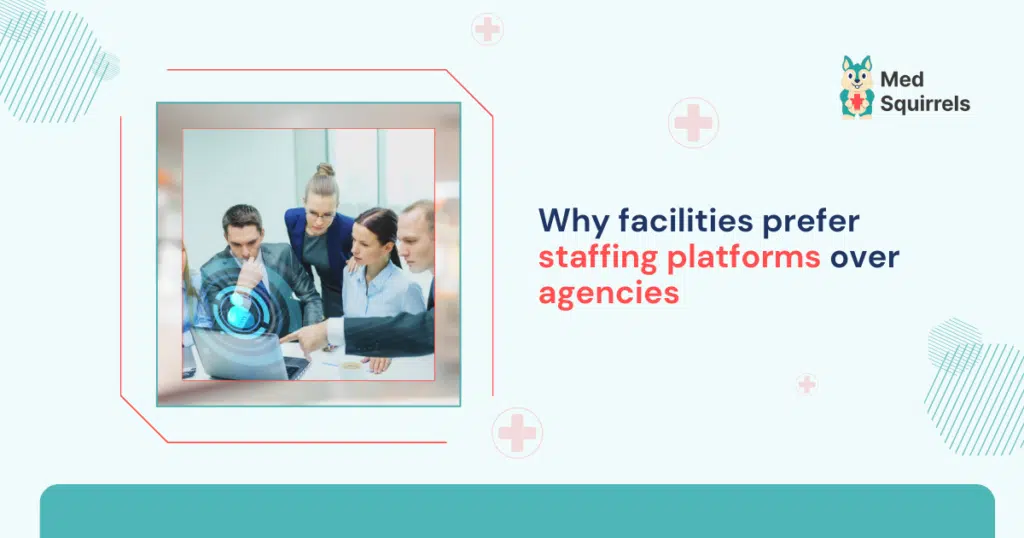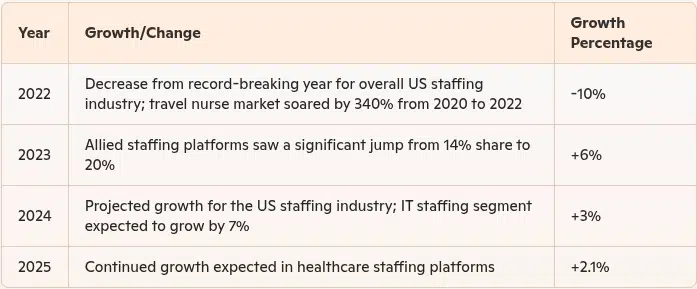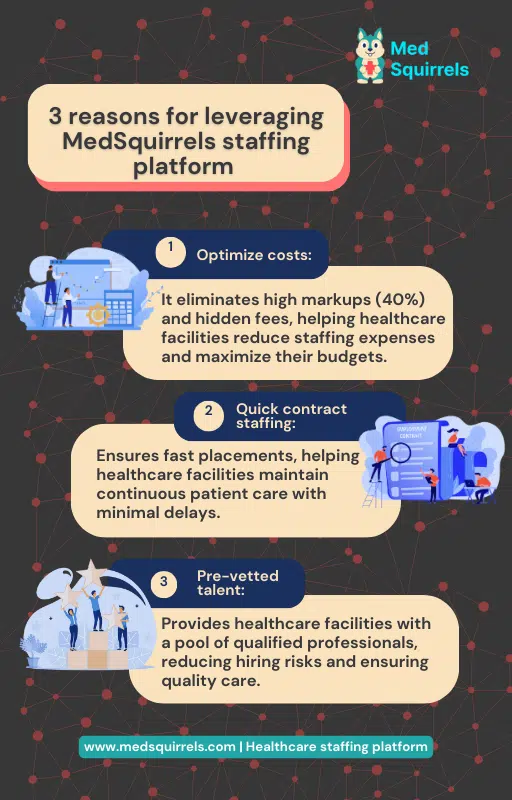Why facilities prefer staffing platforms over agencies

The healthcare industry is bracing for significant staffing challenges. The two crucial issues are nursing shortages and workforce burnout. According to the healthcare innovation’s publishing based on McKinsey & Company, the United States may see a shortage of 200,000 to 450,000 registered nurses by 2025. Widespread burnout, exacerbated by patient surges and administrative burdens, pushes medical professionals to leave the field entirely. To combat these issues, many healthcare facilities are turning to healthcare staffing platforms offering streamlined recruitment, optimized scheduling, and enhanced compliance management. This blog explores how these platforms are emerging as a vital solution for overcoming workforce obstacles and improving patient care.
Traditional staffing agencies and their limitations
Traditional staffing agencies have forever preferred healthcare institutions in search of employees. Nonetheless, their shortfalls are ever more evident due to the dynamic changes in the healthcare industry. Such limitations may turn into potential inefficiencies and lead to cost surges in healthcare facilities.
Limited transparency
- Usually, agencies are not clear about their cost estimation or how they select candidates so healthcare providers can make informed decisions. The lack of transparency is the leading cause of the difficulties faced in many cases.
- The absence of precise data leads to poor indicator tracking, which means that healthcare facilities fail to achieve effective workforce solutions.
Tedious recruitment and credentialing
- Recruitment and credentialing are long and taxing procedures that slow down hiring and patient care, which depend, in this case, on healthcare facilities.
- A long recruitment process makes it difficult to solve the problem of staffing shortages quickly, thus requiring a more efficient healthcare staffing technology.
High costs with markups from 25% to 100%
- The prices set by the agency, which in most cases are between 25% and 100%, are beyond the budgets of the healthcare providers. This results in using resources in other essential areas, affecting the operation of more cost-effective staffing solutions.
- Budget constraints may force difficult decisions about staffing levels, emphasizing the need for more affordable healthcare workforce solutions.
The rise of staffing platforms
In recent years, healthcare facilities across the United States have increasingly adopted staffing platforms to meet growing workforce demands. These platforms leverage cutting-edge technologies such as artificial intelligence (AI), data analytics, and mobile apps to streamline the hiring process and manage staffing needs more efficiently. As hospitals and other healthcare providers face challenges in managing their workforce, staffing platforms have emerged as a critical solution, offering flexibility, reducing administrative burdens, and improving staff retention. The rise of these platforms has significantly outpaced the growth of traditional staffing agencies, with healthcare facilities increasingly relying on these digital solutions to meet their staffing needs. This below table summarizes the growth and changes in the US staffing platforms from 2022 to 2025, highlighting key developments and growth percentages for each year.
US staffing platform growth: 2022-2025

Source: Staffing Industry Analysts
This data highlights the substantial rise of staffing platforms in healthcare facilities over the past five years. As these platforms continue to gain traction, healthcare providers are moving away from traditional staffing agencies, favoring more agile and technology-driven solutions to address their workforce needs. Note: The growth for staffing platforms shows a significant increase of 340% in 2020 compared to 2021 and subsequent steady growth each year, while staffing agencies have maintained a stable growth rate of 2.7% annually.
Key benefits of staffing platforms
Healthcare workforce solutions offer numerous advantages that address the limitations of traditional agencies. As detailed below, these benefits drive their increasing adoption within healthcare facilities.
Cost efficiency
- Healthcare staffing platforms promote transparent pricing models, helping healthcare facilities understand and manage their expenditures. This allows them to cut the cost of recruiting, enhance the facility’s efficiency, and make medical organizations more profitable.
- These platforms present more cost-effective staffing solutions by minimizing overhead and administrative expenses than the conventional agency model.
Speed and flexibility
- Staffing platforms expedite hiring, granting healthcare facilities quick access to a broader pool of candidates. The facility can quickly fill vacant shifts with RNs, LPNs, CNAs, or other clinicians—as needed, which is often an essential benefit for hospitals.
- These solutions swiftly enable healthcare facilities to adapt to fluctuating staffing demands, ensuring optimal coverage and care.
Quality of candidates
- Staffing platforms employ enhanced vetting processes and sophisticated matching algorithms to identify highly qualified candidates. Viewing the applicants’ profiles quickly to see who is most suitable for the job.
- By prioritizing skills and experience, healthcare facilities can improve the quality of care and reduce risks.
Improved communication
- These platforms offer real-time updates and streamlined communication channels, fostering stronger collaboration between healthcare facilities and staff1.
- User-friendly interfaces enhance the overall experience for both employers and candidates, making it easier to get in contact.
These benefits show how healthcare facilities can revolutionize their operations by implementing new healthcare workforce solutions.
The future of healthcare staffing
The future of healthcare staffing is increasingly connected with technology and innovation, which demands that healthcare facilities align with new workforce requirements trends. As we have shifted to 2025, trends are being driven by anything from telemedicine and AI to flexible work culture and new worker expectations. Healthcare workforce solutions must utilize these elements to optimize operations and enhance patient care. By integrating advanced technologies, healthcare facilities can streamline workflows and improve efficiency. This proactive approach will also help attract and retain top talent, ensuring a sustainable and effective workforce.

MedSquirrels: a tech-driven staffing platform for healthcare facilities
As healthcare facilities grapple with ongoing staffing challenges, the shift from traditional staffing agencies to technology-driven staffing platforms is not just a trend but a necessity. These platforms address critical transparency, speed, cost, and candidate quality limitations. While challenges like technology reliance and maintaining the human element must be considered, the benefits of optimized workflows and improved patient care are undeniable.
Platforms like MedSquirrels are revolutionizing healthcare staffing by offering transparent pricing and streamlined processes. By eliminating agency mark-ups and enabling upfront compensation agreements, MedSquirrels delivers cost savings and enhances trust, allowing healthcare facilities to thrive and improve patient outcomes.
MedSquirrels offers contractual and full-time hiring solutions catering to the staffing needs of healthcare facilities. Whether hiring contract professionals or permanent staff, MedSquirrels simplifies recruitment, credentialing, payrolling, and benefits management.
MedSquirrels provides three staffing plans:
- Orange Plan: Ideal for contract staffing, it covers recruitment and payroll and benefits management.
- Purple Plan: It offers EOR services that cover onboarding and payroll and benefits administration for healthcare professionals sourced by the facility.
- Blue Plan: It covers sourcing and recruitment of top talent for permanent healthcare job roles.
These plans help healthcare facilities manage their workforce needs, whether they source talent themselves or use MedSquirrels’ services. The platform also benefits providers with streamlined onboarding, consistent compensation, and diverse work opportunities. Click here to know more how MedSquirrels works.
FAQs
Why are healthcare facilities moving away from traditional agencies?
Traditional agencies often have lengthy hiring processes and higher costs, whereas modern healthcare staffing platforms offer faster, more cost-effective solutions. These platforms leverage advanced technology to streamline the recruitment process, reducing time-to-hire and improving overall efficiency for healthcare facilities.
Are staffing platforms more efficient than traditional agencies?
Yes, they are more efficient as these platforms provide quicker placements and better matching of candidates to job requirements. By utilizing AI and data analytics, they ensure that only the most qualified candidates are selected, reducing turnover and improving the quality of care provided by healthcare facilities.
Are staffing platforms faster than traditional agencies?
Modern staffing platforms use AI-powered matching and automated processes to connect facilities with available staff quickly. This technology ensures a more accurate and efficient recruitment process, allowing healthcare facilities to fill urgent positions faster and reduce administrative burdens.
What makes MedSquirrels different from other staffing platforms?
MedSquirrels offers a flat-fee approach, eliminating traditional markups and ensuring fair pay for workers. This transparent pricing model not only reduces overhead costs for healthcare facilities but also promotes a more equitable compensation structure for healthcare professionals.
What are the advantages of using the MedSquirrels platform?
It simplifies staffing with a user-friendly platform and offers data-driven insights for better workforce management. It also eliminates agency markups and allows healthcare facilities to finalize provider compensation upfront, leading to cost savings.
